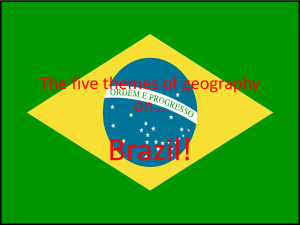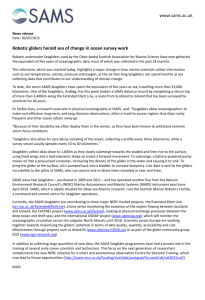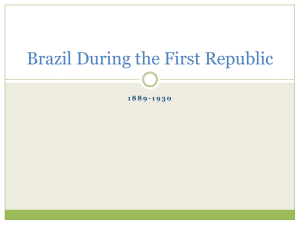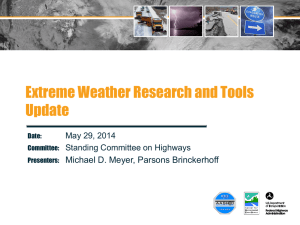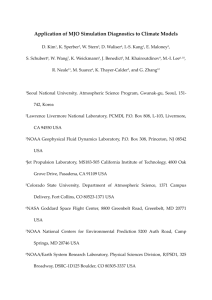South America
advertisement
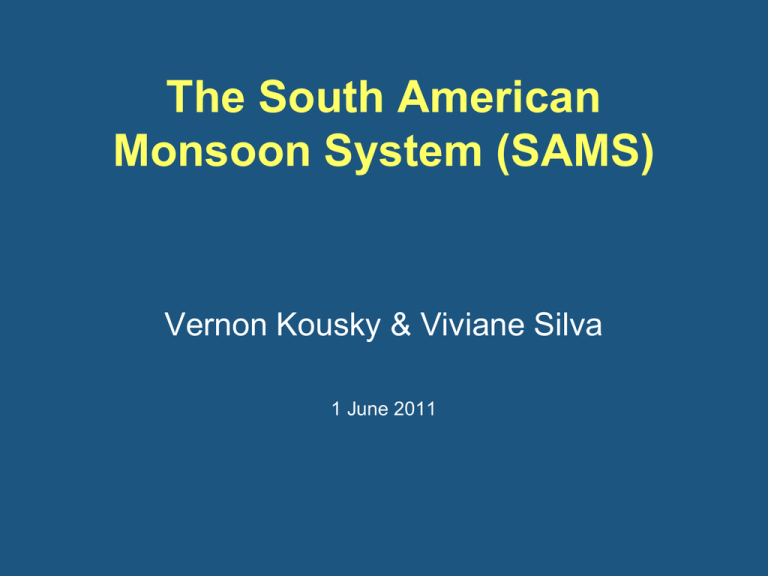
The South American Monsoon System (SAMS) Vernon Kousky & Viviane Silva 1 June 2011 Outline • Key topographic features of South America • Characteristic features of SAMS • Life Cycle of the SAMS wet season – Evolution (precipitation and atmospheric circulation) – Onset, mature and demise phases • SAMS variability – – – – – El Niño/ Southern Oscillation (ENSO) influences Atlantic SST dipole pattern Madden-Julian Oscillation (MJO) impacts South Atlantic Convergence Zone Diurnal Cycle Key Topographic Features Amazon Basin Andes Mountains BP Brazilian High Plains (Planalto) Parana Basin SAMS: Characteristic Features The annual cycle of precipitation Distinct wet and dry seasons occur between the equator and 25ºS. Many areas within that region receive more than 50% of their total annual precipitation during the austral summer (Dec-Feb), and less than 5% of their total annual precipitation during austral winter (Jun-Aug). Percent of annual mean (1975-2003) precipitation. SAMS: Characteristic Features A During the wet season an upper-tropospheric anticyclone (red A) dominates the circulation over tropical and subtropical South America, while cyclonic flow (troughs – dashed black lines) dominates the uppertropospheric circulation over low latitudes of the eastern South Pacific and central South Atlantic H L H Prominent low-level features include: 1) surface high pressure systems and anticyclonic circulation over the subtropical oceans (Pacific and Atlantic), 2) a surface low-pressure system (Chaco Low) centered over northern Argentina, and 3) a low-level northwesterly flow (low-level jet) extending from the southwestern Amazon to Paraguay and northern Argentina. Throughout the region one notes a reversal of circulation features between the lower troposphere and the upper troposphere, which is typical in the global Tropics. A C A A Life Cycle of the SAMS Wet Season The annual cycle of upper-tropospheric circulation features over South America is intimately linked to the seasonally varying horizontal temperature gradients, which arise from differential heating between land and water. Life Cycle of the SAMS Wet Season During summer, temperatures over the continent become warmer than the neighboring oceanic regions. This results in a direct thermal circulation with low-level (upper-level) convergence (divergence), midtropospheric rising motion and wet conditions over the continent, and low-level (upper-level) divergence (convergence), midtropospheric sinking motion and dry conditions occur over the neighboring oceanic areas. Red (blue) indicates divergence (convergence) South America Blue indicates cold cloud top temperatures Life Cycle of the SAMS Wet Season During winter, temperatures over the continent and nearby oceanic regions are more uniform, which gives rise to a more zonally symmetric uppertropospheric circulation pattern over the region and little or no evidence of any east-west direct thermal circulation Red (blue) indicates divergence (convergence) South America Blue indicates cold cloud top temperatures Meridional Circulation: January and July 10-20S SH Summer: upper-level divergence, low-level convergence, rising motion SH Winter: upper-level convergence, low-level divergence, and subsidence South America Life Cycle of the SAMS Wet Season Green and blue colors indicate cold cloud top temperatures, which in the Tropics are associated with deep convection. Life Cycle of the SAMS Wet Season The development of the South American warm season Monsoon System, during Sep-Nov, is characterized by a rapid southward shift of the region of intense convection from northwestern South America to the southern Amazon Basin and Brazilian highlands (altiplano) (see next slide). Blue colors indicate cold cloud top temperatures, which in the Tropics are associated with deep convection. Life Cycle of the SAMS Wet Season Lower-Atmospheric temperatures reach their annual maximum over the southern Amazon and altiplano region in early September, just prior to the onset of the rains. Life Cycle of the SAMS Wet Season • Transient synoptic systems at higher latitudes play an important role in modulating the southward shift in convection. • Cold fronts that enter northern Argentina and southern Brazil are frequently accompanied by enhanced deep convection over the western and southern Amazon and an increase in the southward flux of moisture from lower latitudes. A • Cold fronts are also important in the formation of the South Atlantic Convergence Zone (SACZ), which becomes established in austral spring over Southeast Brazil and the neighboring western Atlantic. South Atlantic Convergence Zone (SACZ) Green and blue colors indicate cold cloud top temperatures, which in the Tropics are associated with deep convection. • During spring an upper-tropospheric anticyclone (Bolivian High) becomes established near 15ºS, 65ºW, as the monsoon system develops mature-phase characteristics. • Upper-level troughs and dry conditions are found over oceanic areas to the east and west of the Bolivian High. • The deep convection over central Brazil and the Bolivian High reach their peak intensities during December-February. • These features shift northward and weaken during March-May, as the summer monsoon weakens and a transition to drier conditions occurs over subtropical South America. Brazil Wet Season Onset & Demise ONSET DEMISE SAMS Variability • Interannual Variabiliy - El Niño and La Niña impacts, Atlantic SST dipole pattern • Intraseasonal Variability – Madden-Julian Oscillation (MJO) – South Atlantic Convergence Zone (& cold fronts) • Diurnal Cycle Precipitation Anomaly Patterns during El Niño Episodes over Brazil The pattern of anomalous precipitation over Brazil for the water year (July-June) for El-Nino episodes. Composite shows wetter than average to the south and drier than average to the north, with considerable event-to-event variability in the intensity and extent of the anomalies. From Silva et al., 2007 Precipitation Anomaly Patterns during La Niña Episodes over Brazil The pattern of anomalous precipitation over Brazil for the water year (July-June) for La Nina episodes. Composite shows wetter than average to the north and drier than average to the south, with considerable event-to-event variability in the intensity and extent of the anomalies, especially over southern Brazil. From Silva et al., 2007 Atlantic Dipole Atlantic Dipole Pattern Suppressed convection Enhanced convection Low-level westerly wind anomalies are consistent with positive SST anomalies along the equator and a southward shift in the ITCZ, resulting in heavy rainfall in Northeast Brazil. MJO Impacts • The MJO modulates summer rainfall over northern and northeastern South America with a period of 30-60 days. • Very important for Northeast Brazil (semiarid region), which experiences a short (34 month) wet season. 200-hPa Velocity Potential Anomalies (5°S-5°N) Positive anomalies (brown shading) indicate unfavorable conditions for precipitation Negative anomalies (green shading) indicate favorable conditions for precipitation • From mid-March to early May 2009, eastward propagating velocity potential anomalies indicated moderate-to-strong MJO activity. • The active phase of the MJO was in the South American sector (phase 8) during the end of March and again in the beginning of May, contributing to excessive rainfall and flooding over northeastern Brazil during those periods. Time Longitude Rainfall over northeastern South America (MAM) BP - Rainfall totals over northeast Brazil during 11 March-6 June 2009 were above-average (surpluses of 210-600 mm). Note the increased rainfall at the end of March and again at the beginning of May, associated with the convectively active phase of the MJO. SACZ Variability: The South American Dipole Pattern The OLR anomaly patterns often show a dipole of positive and negative values along the east coast of Brazil. SACZ Variability: The South American Dipole Pattern The dipole pattern is found over eastern South America in the region of greatest OLR variability, which extends from southern Brazil northeastward to Northeast Brazil. SACZ Variability: The South American Dipole Pattern The mid-tropospheric vertical motion also displays a dipole pattern, with upward vertical motion (negative omega) in the region of negative OLR anomalies (anomalously strong convection and rainfall) and sinking motion to the south. SW NE SACZ Variability: The South American Dipole Pattern • Cold fronts play an important role in organizing convective activity in the region of the SACZ. • Sometimes this leads to extreme events (exceptionally heavy rainfall and flooding over a period of several days). Diurnal Cycle of Precipitation Based on CMORPH Vernon E. Kousky, John E. Janowiak and Robert Joyce Climate Prediction Center, NOAA CMORPH (CPC Morphing technique) Uses IR data along with passive microwave data to create global rainfall analyses (60N60S) at high spatial and temporal resolution. CMORPH uses IR only as a transport vehicle, i.e. IR data are NOT used to make estimates of rainfall when passive microwave data are not available. The underlying assumption is that the error in using IR to transport precipitation features is less than the error in using IR to estimate precipitation. Specifics • Spatial Grid: 0.0728o lat/lon (8 km at equator) • Temporal Resolution: 30 minutes • Domain: Global (60o N - 60o S) • Period of record: Dec. 2002 – present For more information about CMORPH: http://www.cpc.ncep.noaa.gov/products/janowiak/cmorph.html Methodology • The seasonal mean precipitation rates, from CMORPH, are computed for each time interval (1-h or 3-h). • The mean daily precipitation rates are computed by summing the 1-h rates for the 24-h period. • In the absence of any diurnal variability, the same amount of rainfall would be expected during each time interval (e.g., 100/24 = 4.2% for 1-h intervals and 100/8 = 12.5% for 3-h intervals). • Brown (green) colors are used to depict times when the observed % is less (more) than the expected values (precipitation uniformly distributed throughout the 24-h period). DJF - South America (1mm mask) The amplitude of the diurnal cycle is large over northeastern South America, the Andes Mts. And southeastern Brazil. (Compare top left and bottom right panels, or toggle back and forth between this slide and the following slide.) DJF - South America (1mm mask) The amplitude of the diurnal cycle is large over northeastern South America, the Andes Mts. And southeastern Brazil. (Compare top left and bottom right panels, or toggle back and forth between this slide and the previous slide.) South America: DJF (1 mm/d mask) Westward moving organized features are evident over Tropical South America, and eastward moving features are evident in the vicinity of the Andes Mts. (15S30S). Time (LST) of Max. Precipitation: South America – DJF 2002-03 15-18 LST 21-24 LST 08-11 LST 03-06 LST 02-05 LST 09-12 LST 20-23 LST 15-18 LST Time-Longitude Diurnal Cycle EQ DJF The mean diurnal cycle is repeated four times. A westward moving feature (dashed black line) is evident between 50W and 60W. Time Longitude East Coast MAM Mean Diurnal Cycle – EQ-5N Convective rainfall systems start along the east coast on day1 and propagate westward, reaching the western Amazon Basin on day3. Day1 Day2 Day3 Day4 West Coast East Coast Seasonal variations of the Diurnal Cycle of Precipitation over the Amazon Basin An afternoon peak is observed throughout the year. A secondary nocturnal peak is evident during Jan-May. topography A strong diurnal cycle is evident over Southeast Brazil and the western Atlantic Ocean. Seasonally varying diurnal cycle of preciitation (area averaged 2x2 degrees), 2S. 55W 52W 49W 46W Westward propagating lines near the Equator occur primarily during February-May. Summary • Characteristic features of SAMS (precipitation, atmospheric circulation) • Life Cycle of the SAMS wet season • SAMS variability – – – – – El Niño/ Southern Oscillation (ENSO) influences Atlantic SST dipole pattern Madden-Julian Oscillation (MJO) impacts South Atlantic Convergence Zone Diurnal Cycle



